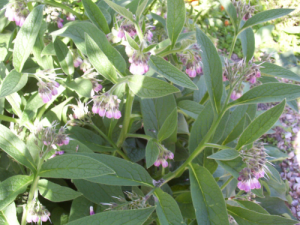Comfrey- one of nature’s multipurpose herbs by Ginny Clayton
Comfrey (Symphytum officinale) is a very important herb, with many attributes. It has been around a very long time, and is still very important for us today.
It is a winter dormant perennial herb, providing lots of lovely lush green leaves for use in summer, and pink bell-like flowers which are loved by bees. It is from the same family as borage, which is one of the best bee plants ever, with its beautiful blue flowers.
Comfrey is a brilliant companion plant in your orchard- it has very thick fleshy roots that break up the subsoil as they grow down, and give the worms a great place to live, thus encouraging them to stay around- with their constant activity it is like making fresh compost on the spot, which is great for the trees.
This herb is also well known as ‘poultry medicine’. They will eat it when they need to; it helps control intestinal parasites, lice, etc., so it is a good idea to plant some in their pen- or run them in your orchard! It is a good idea to cover the plant with a chicken netting barrier so they can only reach the leaves.
There is a downside to comfrey. It must be planted where you are not going to disturb the roots- every little piece will grow, and therefore it can become a real pest if disturbed by a rotary hoe or similar and transported to other areas of your property. However, if planted under fruit trees, or in the chook pen where you are only going to harvest the leaves in summer it will grow in ever increasing clumps where you plant it.
This herb is also great in compost- it acts as an activator, is full of potassium, calcium and vitamins A, B12 and C.
The medicinal side of comfrey is legendary- it is also known as bone knit, among other names, for its ability to heal tissue and bone. Besides broken bones comfrey poultices from the leaves and roots are also used for cuts, bruises and sprains. The importance of comfrey is due to its allantoin content, which promotes the growth of connective tissue, bone and cartilage, and the fact that it is easily absorbed through the skin.
How to make a comfrey poultice: Place washed comfrey roots or leaves in a blender with some calendula tincture- blend. In a small saucepan, over very low heat, heat to a comfortable, soothing temperature, stirring constantly. Spread the paste thickly onto a clean piece of old cotton material, fold and place onto the wound, sprain, or broken bone area. Wrap with a bandage and leave on about 30 minutes. Use the comfrey poultice several times per day for an initial injury. Poultices last several days in the fridge, and can be frozen


